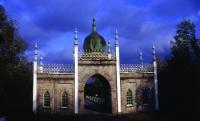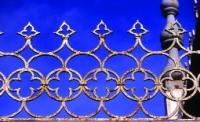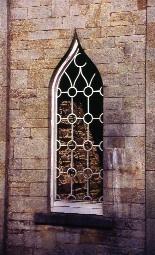Gems of Architecture:Dromana Gate, Co. Waterford
Published in 18th–19th - Century History, Features, Issue 4 (July/August 2010), Volume 18
‘One of the strangest gatelodges in the country’—note the decorative glazing bars (inset top) complemented by a quatrefoil-detailed filigree parapet (inset below) overhead. (Patrick Donald)
The origins of the Dromana Gate on the periphery of the Dromana Forest, near Cappoquin, Co. Waterford, can be traced back to a papier-mâché-detailed canvas-covered timber structure erected in 1826 by the tenants of Villierstown to welcome home the newly wed Henry Villiers-Stuart (1803–74), Lord Stuart de Decies, and Theresia Pauline Ott (d. 1867). It is said that the Villiers-Stuarts spent at least some of their honeymoon in Brighton on the south English coast, and the gate, interpretable as a vast reduction of the Royal Pavilion (built 1815–22), the centrepiece of that emerging seaside destination, would appear to support such a claim. Built as a retreat for King George IV (1760–1832), then Prince Regent, to a design by John Nash (1752–1835), the eccentric Brighton Pavilion represented a radical departure from the cheerless Classicism monopolising the mainstream taste and exploited, on the exterior, almost every conceivable motif derived from indigenous Indian architecture and, in the state apartments, fanciful decorative themes melding Chinese and Indian patterns.
 Surviving drawings for the present ‘permanent’ gateway, a folly-like composition overlooking the Finisk River, are signed and dated (1849) by Martin Day (d. 1861), a native of Gallagh, Co. Wexford, best remembered today for his collaborations with Daniel Robertson (d. 1849) on a series of country houses in that county. Day would appear to have been the architect of choice for Villiers-Stuart, and his earliest drawings illustrate a portico for the ongoing ‘improvement’ of Dromana House and a range of ‘offices’ (1822) commissioned by the trustees of the estate of Lady Gertrude Amelia Mason-Villiers (d. 1809), Henry not yet having come of age. A later drawing (1826?) shows an unexecuted proposal for a Classical gateway, while further alterations were made to the house and stables from 1843, upon completion of which (1849) Day began work on the Dromana Gate. The Georgian substance of Dromana House having been demolished in 1966, the Dromana Gate survives as Martin Day’s enduring contribution to the estate.
Surviving drawings for the present ‘permanent’ gateway, a folly-like composition overlooking the Finisk River, are signed and dated (1849) by Martin Day (d. 1861), a native of Gallagh, Co. Wexford, best remembered today for his collaborations with Daniel Robertson (d. 1849) on a series of country houses in that county. Day would appear to have been the architect of choice for Villiers-Stuart, and his earliest drawings illustrate a portico for the ongoing ‘improvement’ of Dromana House and a range of ‘offices’ (1822) commissioned by the trustees of the estate of Lady Gertrude Amelia Mason-Villiers (d. 1809), Henry not yet having come of age. A later drawing (1826?) shows an unexecuted proposal for a Classical gateway, while further alterations were made to the house and stables from 1843, upon completion of which (1849) Day began work on the Dromana Gate. The Georgian substance of Dromana House having been demolished in 1966, the Dromana Gate survives as Martin Day’s enduring contribution to the estate.
 Described by James Howley in 1993 as ‘one of the strangest gatelodges in the country’, at the heart of the Dromana Gate is a remarkably simple composition comprising a central gateway flanked on either side by single-cell chambers or porters’ lodges; the symmetry of the façades is continued beneath the vaulted gateway, where false doors flank the entrances to the lodges. While the curvilinear profile of the openings, the decorative glazing bars complemented by a quatrefoil-detailed filigree parapet overhead, might have been familiar through their appearance in contemporary Georgian Gothic ecclesiastical architecture, the slender minaret-topped piers framing a copper-clad onion dome, easily the most recognisable shorthand for the ‘exotic’ in architecture, were undoubtedly a new experience for the casual observer.
Described by James Howley in 1993 as ‘one of the strangest gatelodges in the country’, at the heart of the Dromana Gate is a remarkably simple composition comprising a central gateway flanked on either side by single-cell chambers or porters’ lodges; the symmetry of the façades is continued beneath the vaulted gateway, where false doors flank the entrances to the lodges. While the curvilinear profile of the openings, the decorative glazing bars complemented by a quatrefoil-detailed filigree parapet overhead, might have been familiar through their appearance in contemporary Georgian Gothic ecclesiastical architecture, the slender minaret-topped piers framing a copper-clad onion dome, easily the most recognisable shorthand for the ‘exotic’ in architecture, were undoubtedly a new experience for the casual observer.
















